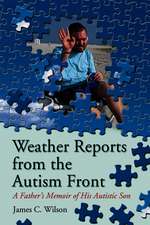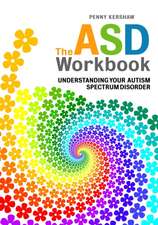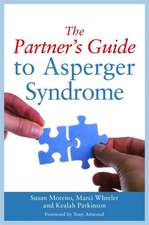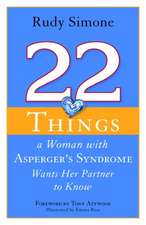Asperger's Syndrome: A Guide to Helping Your Child Thrive at Home and at School
Autor Melinda Docter, Syed Naqvien Limba Engleză Paperback – 2 sep 2010
Preț: 86.18 lei
Preț vechi: 90.72 lei
-5% Nou
Puncte Express: 129
Preț estimativ în valută:
16.49€ • 17.91$ • 13.85£
16.49€ • 17.91$ • 13.85£
Carte disponibilă
Livrare economică 01-15 aprilie
Preluare comenzi: 021 569.72.76
Specificații
ISBN-13: 9780470140147
ISBN-10: 0470140143
Pagini: 218
Dimensiuni: 152 x 229 x 18 mm
Greutate: 0.23 kg
Editura: Wiley (TP)
Locul publicării:Hoboken, United States
ISBN-10: 0470140143
Pagini: 218
Dimensiuni: 152 x 229 x 18 mm
Greutate: 0.23 kg
Editura: Wiley (TP)
Locul publicării:Hoboken, United States
Descriere
How to help a child with Asperger′s syndrome grow and prosper If you are raising a child with Asperger′s syndrome, it can be a real challenge to find answers to your questions and to follow the latest research developments while also trying to keep pace with day–to–day changes in the growth and behavior of your child. This book comes to the rescue by combining the latest medical information and interventions with clear–cut strategies to help your son or daughter at home and at school, from learning how to play with other kids to following a teacher′s instructions. Written by a medical doctor and by an educator who has a son with Asperger′s, it gives you: A parent′s guide to diagnosis, plus information on school options, the Individual Educational Plan (IEP), and assessments The most up–to–date scientific data on Asperger′s syndrome, including the latest neuroimaging research The pros and cons of available medical treatments, complementary therapies, and early intervention strategies Practical strategies for shaping social interactions, coping with repetitive thoughts and behavior, addressing sensory needs or avoidance, and encouraging interests without enabling obsessions
Textul de pe ultima copertă
How to help a child with Asperger′s syndrome grow and prosper If you are raising a child with Asperger′s syndrome, it can be a real challenge to find answers to your questions and to follow the latest research developments while also trying to keep pace with day–to–day changes in the growth and behavior of your child. This book comes to the rescue by combining the latest medical information and interventions with clear–cut strategies to help your son or daughter at home and at school, from learning how to play with other kids to following a teacher′s instructions. Written by a medical doctor and by an educator who has a son with Asperger′s, it gives you: A parent′s guide to diagnosis, plus information on school options, the Individual Educational Plan (IEP), and assessments The most up–to–date scientific data on Asperger′s syndrome, including the latest neuroimaging research The pros and cons of available medical treatments, complementary therapies, and early intervention strategies Practical strategies for shaping social interactions, coping with repetitive thoughts and behavior, addressing sensory needs or avoidance, and encouraging interests without enabling obsessions
Cuprins
Introduction. Chapter 1 A Mother’s Longing to Understand Her Son. Chapter 2 Diagnostic Challenges in Asperger’s Disorder. Chapter 3 Co–morbid Disorders – Isn’t having just Asperger’s syndrome enough? Chapter 4 The Parents Guide to Recognizing and Diagnosing. Chapter 5 Next Steps. Chapter 6 Repetitive Thoughts and Behaviors: When Your Child Can’t Stop Thinking About Vacuums and Other Such Objects. Chapter 7 Theory of Mind: How to Walk in My Shoes. Chapter 8 Attention Deficit Hyperactivity Disorder and Executive Function: Putting Your Thoughts in Order. Chapter 9 Communication: The Door to Friendships, Independence and Knowledge. Chapter 10 Anxiety and Depression: Worries and Sadness. Chapter 11 Sensory Needs or Avoidance: Itchy Clothes; Foods that Smell, and Noisy Rooms. Chapter 12 Behavior as Communication: I Will Make You Understand Even if My Words Don’t Make Sense. Chapter 13 Current and Future Research in Neuro–imaging. Chapter 14 Helpful Hints to Live By. Workbook. Index.
Notă biografică
MELINDA DOCTER, ED.D., is the principal at Junior Blind of America′s Special Education School, which provides services to children with multiple severe disabilities and autism. She was previously the principal at The Help Group′s Village Glen School, which specializes in education and behavior intervention for children with autism and Asperger′s syndrome. SYED NAQVI, M.D., F.A.P.A., is director of the Pediatric PsychopharmacologyClinic in the Department of Psychiatry and Behavioral Neurosciences at Cedars–Sinai Medical Center. He provides state–of–the–art psychopharmacological treatment to children with autism, Asperger′s syndrome, attention deficit hyperactivity disorder, and other disorders.

























